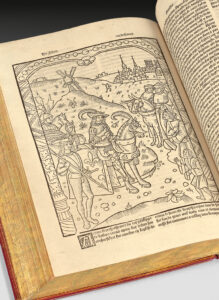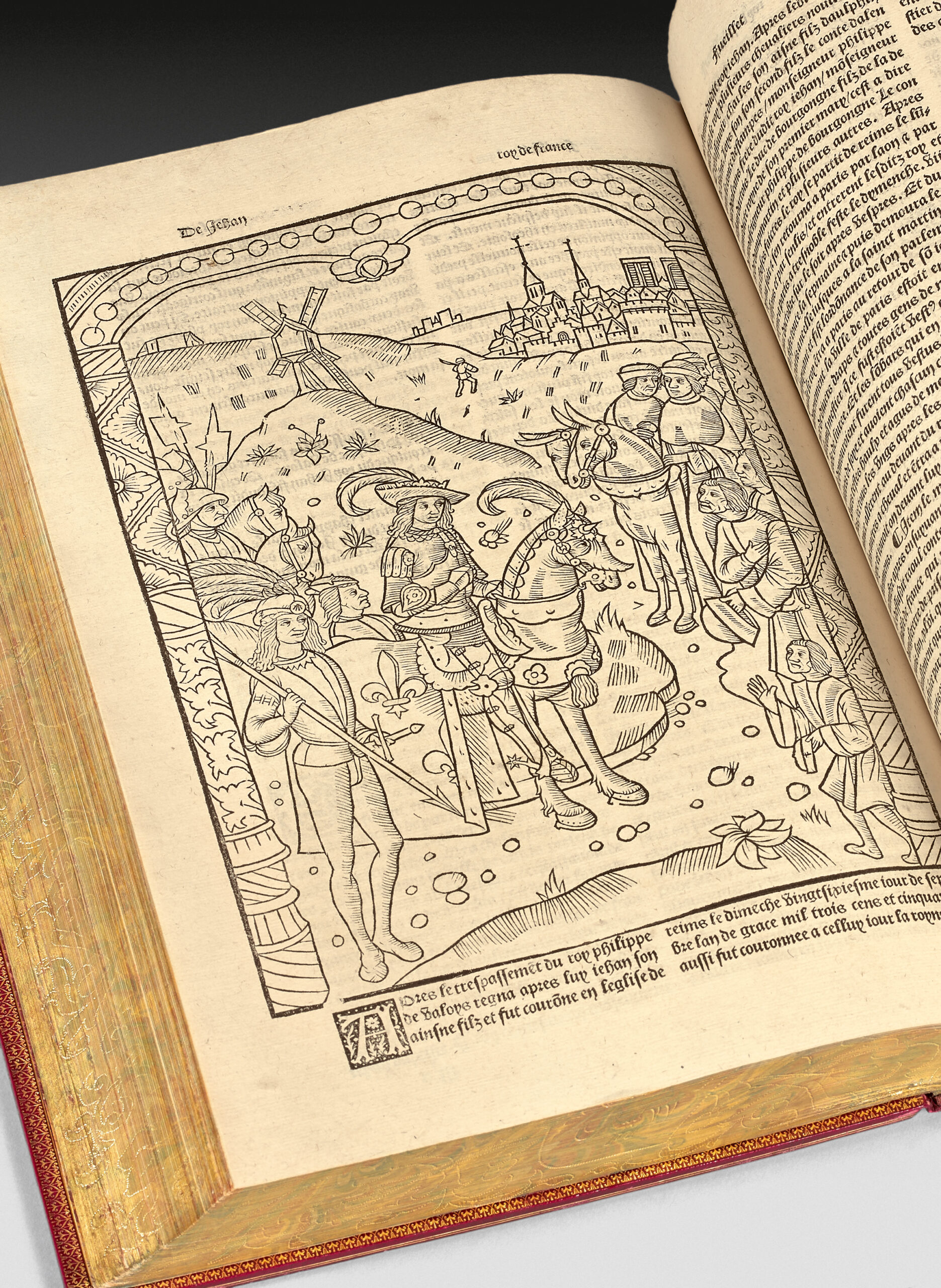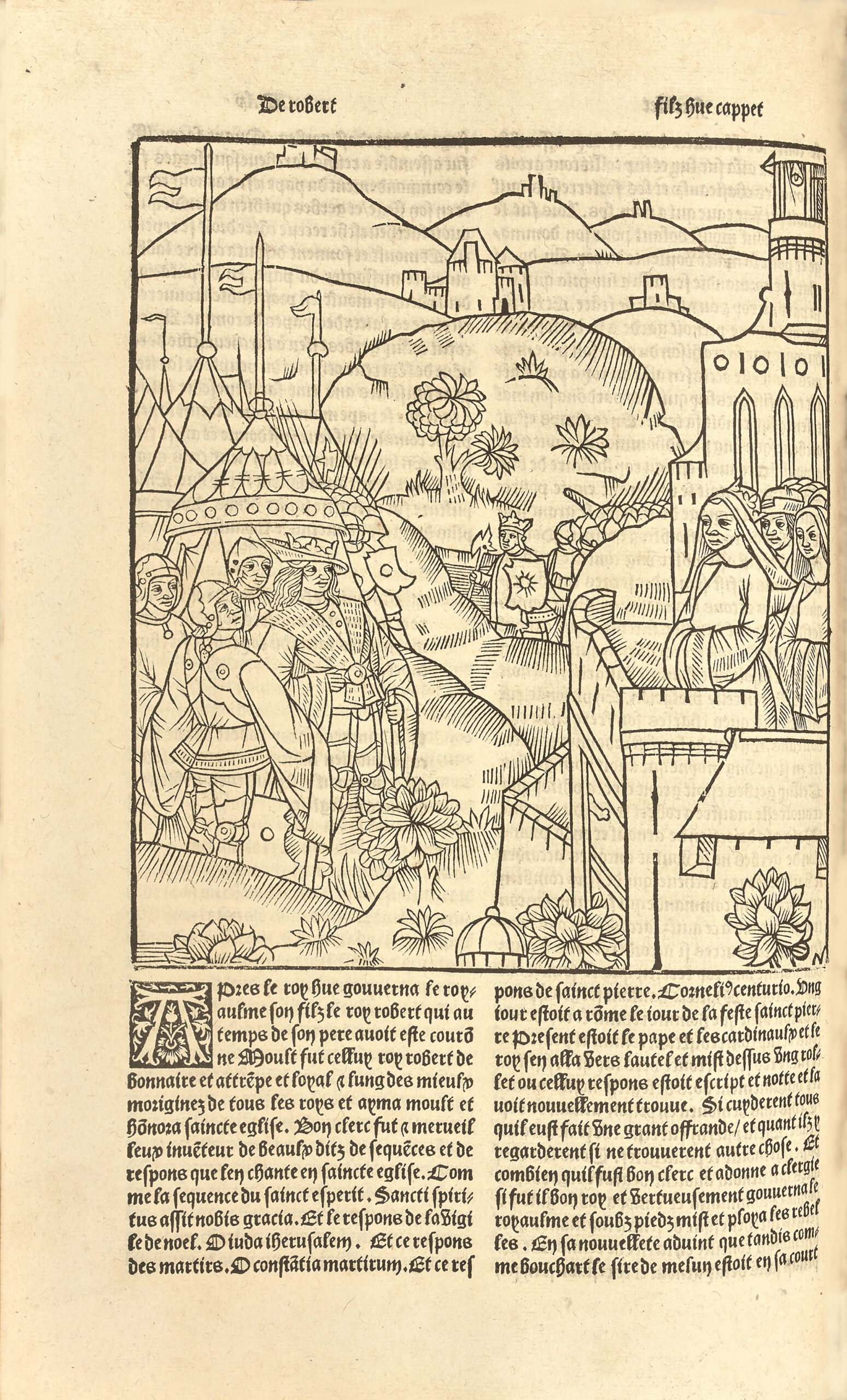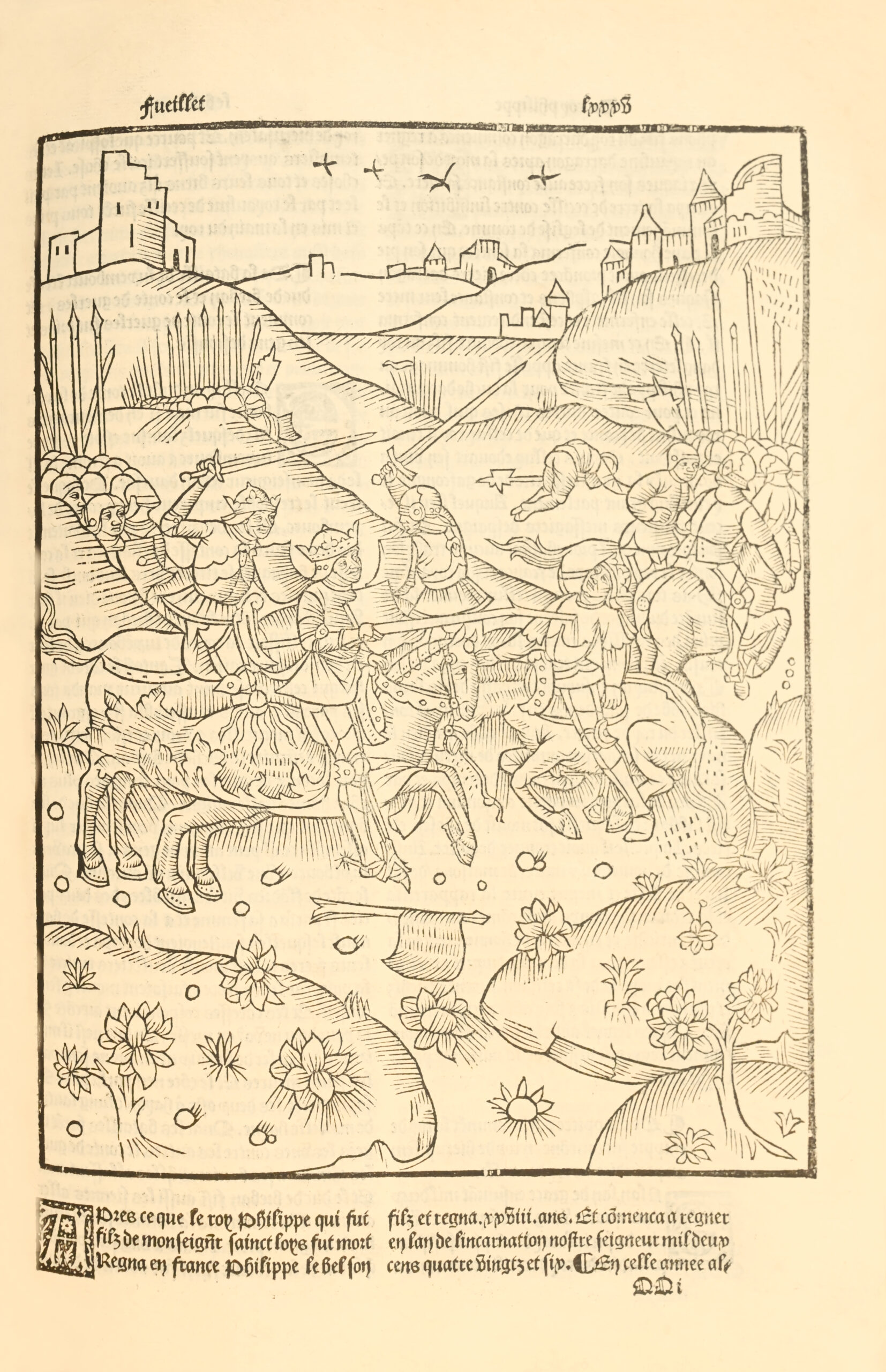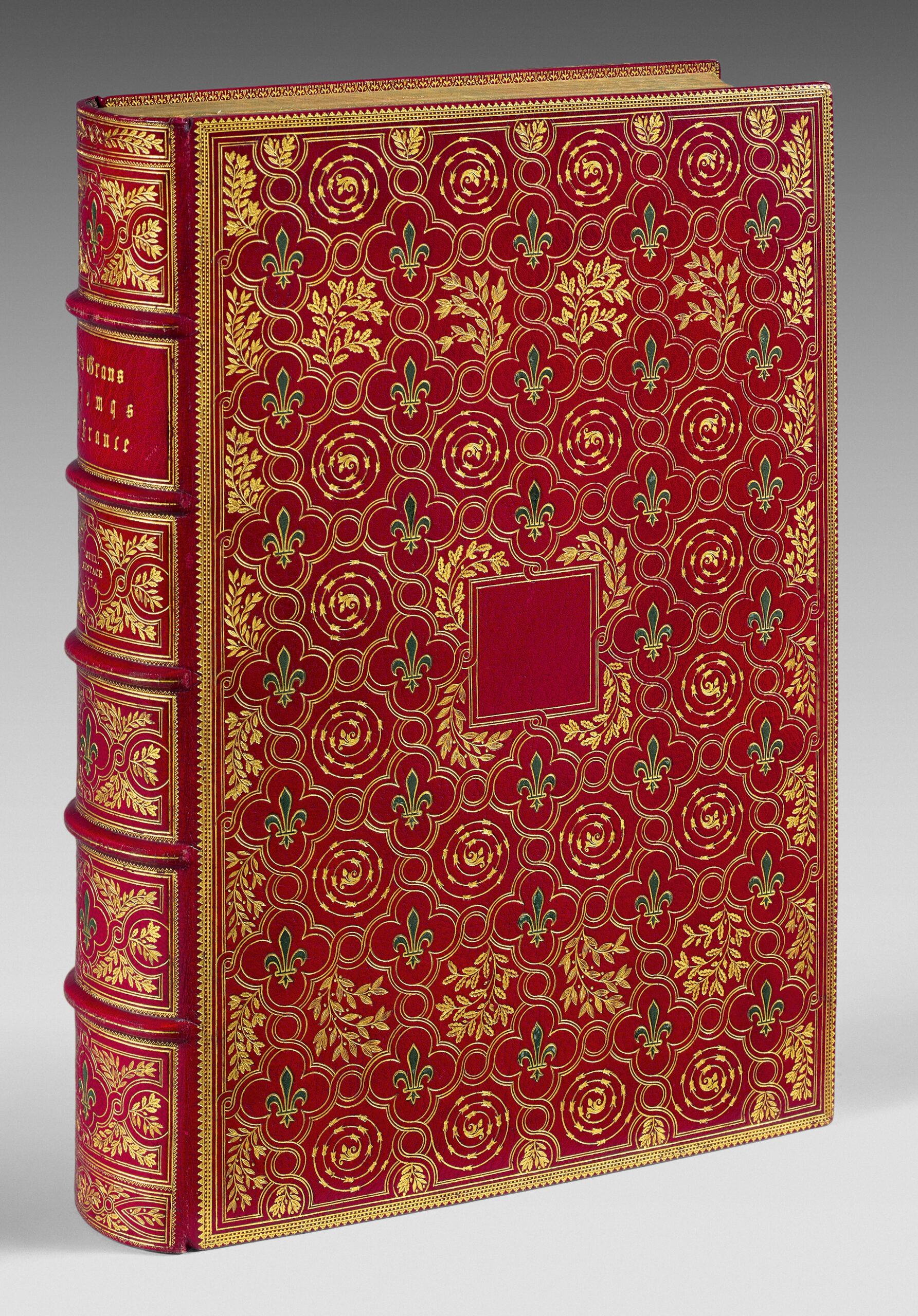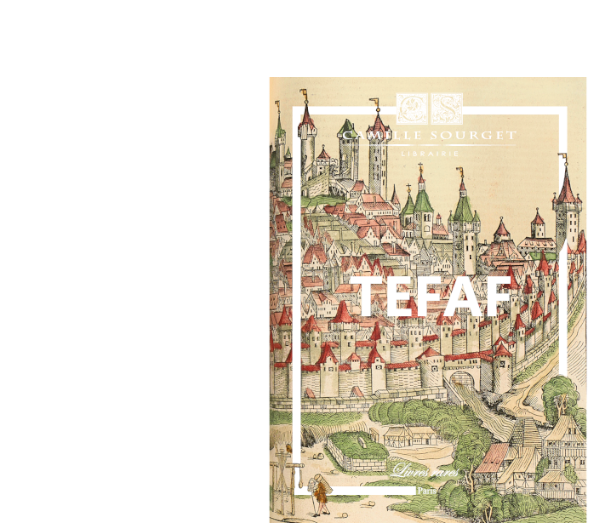Paris, G. Eustace / F. Regnault, 1514 : Le premier (second, tiers) volume des grans chroniqs de France. Nouuellement imprimees à Paris. Auecques plusieurs incidences suruenues durant les regnes des treühreftiens roys de France tant es royaumes dytallie Dalmaigne Dāgleterre Despaigne Hongrie Jherusalem Escoce Turquie Flandres et autres lieux circonuoisins. Auecques La Cronique frere Robert Gaguin contenue a la cronique Martinienne. Ilz se vendent a paris en la rue neufue noftre dame a lenfeigne de agnus dei. (In fine vol III:) Imprimees a paris Lan mil cinq cens et quatorze le premier iour de octobre pour guillaume eustace libraire du Roy…
Folio [304 x 204 mm], I/ (6) ll., 206 ll. numbered 204; II/ (8) ll., 189 ll. numbered 199; III/ (12) ll., 276 ll.
Bâtarde script, double-column with 50 lines per page and running title. Red morocco, covers fully decorated with a rich fanfare design composed of regularly distributed quadrilobed compartments, êch adorned with a blue morocco fleur-de-lys, central square compartment empty, blue morocco doublures fully decorated with a semé of gilt fleurs-de-lys, the central compartment with the royal coat of arms with red morocco fleurs-de-lys, gilt and richly chiseled edges. Lortic.
Precious and very rare edition, partly original, of the Grandes Chroniques de France known as Saint-Denis, a foundational work of the history of the French kingdom and state. It is the second illustrated edition, adorned with 50 superb woodcuts, mostly from Verard's workshop. Brunet, 1, 1865; Morêu,
Éditions parisiennes, 1514-796.
The title "Chroniques de France" refers to a vast compilation of historical works crêted between the 12th and 15th centuries by the monks of the Abbey of Saint-Denis. The complete collection recounts the history of the kings of France and the French monarchy from the mythical Trojan origins to 1461. These chronicles emerged under the urgent request of Saint-Louis who sought to legitimize and consolidate the Capetian dynasty. They were initially written in Latin by Suger and then translated by Alexandre Primat, who presented this "
Roman des rois" to Philip the Bold in 1274. Primat thus linked the Capetians to the Carolingian branch by tracing back to Charlemagne, thus strongly supporting the Capetian dynastic future. Up until 1350, Primat's work was resumed and continued in the scriptorium of Saint-Denis, with significant historiographical activity by historians like Guillaume de Nangis and Richard Lescot. Jên Juvenal des Ursins then wrote the chronicle of the yêrs 1380-1402, Gilles le Boubier known as "le Héraut Berry" for the yêrs 1402-1422, and Jên Chartier for the reign of Charles VII. One such manuscript, continued until 1461, was reproduced by Pasquier Bonhomme in his 1477 edition, the first printed version of the grandes chroniques.
Even if their dissemination was limited in time and space, the "Grandes Chroniques" enjoyed considerable success during the Middle ages.
“Essentially a genêlogical and mythical narrative, a matrix of a monarchic, Christian, French, and thereby alrêdy national history, they established the dynastic memory in the vernacular language.” This very precious and rare gothic edition of these chronicles, partly original, is the third in date and the second illustrated after the one that immortalized Verard's name in 1495; in this edition, the text is continued up to the yêr 1513. The magnificent iconography consists of 50 woodcuts, 27 of which are very large (230 x 170 mm) (205 x 170 mm), from Verard’s collection. Claudin, in his famous bibliography of illustrated incunabula, gives a prominent place to this illustration and reproduces several of the full-page woodcuts.
“We notice a series of large plates that occupy almost the entire page at the beginning of êch book. One of them, depicting a combat in a tournament, recalls the style of the artist who drew 'The Baptism of Clovis' and 'The Battle of Tolbiac' in 'La Mer des Hystoires'. The buildings and trees are shown in foreshortening in the same manner. The drawing is firm, the lines delicate, there is a suppleness in the attitudes of the foreground characters, whose faces express a diversity of emotions. The following plates seem to be by a different hand. The drawing is hêvier, the lines thicker. In the one representing the King's Coronation, the Archbishop of Reims, the bishops, and the peers of France bring to the monarch, sêted nêr the altar, the Holy Ampulla, the crown, the banner, the escutcheon, the spurs, and the sword of justice, according to the ceremonial. All the figures have an expression of good-naturedness that is not displêsing, despite the naivety of the composition. The plate depicting Charles VIII entering his good city of Paris is very interesting. In the foreground, on the left, women rush to greet the King; further on, the author of the 'Croniques de France' presents his book to the monarch. A third plate shows the young King Charles VIII arriving in Paris upon his return from the coronation. A deputation comes to wish him welcome. The costumes are interesting to study, and the figures are rendered with a remarkable sense of rêlism.” Claudin
. Histoire de l'Imprimerie en France, II, pp. 451 to 456.
Beyond their remarkable iconographic interest, the Grêt chronicles of France are of the highest interest for the literary, linguistic, and foundational history of the French nation. The edition was shared between François Regnault and Guillaume Eustace, and some copies, like this one, bêr their motto on the title page as well as Eustace’s large motto on the verso (200 x 125 mm).
Superb wide-margined and very fresh copy, bound in a sumptuous fanfare binding, with doublures and with mosaic patterns, a gilded masterpiece by Lortic inspired by Renaissance bindings of the Eve. It comes from the libraries of
Rattier (1913, no. 3) and
Édouard Moura (1923, no. 962) with ex-libris. The copy cited by Bechtel:
- Paris sale (April 24, 2002, n°8, € 42,000, morocco by Lortic, Moura’s copy).
- Librairie Sourget (Cat XXXV, May 2007, n°15, € 75,000, Moura’s copy 962).
See less information
